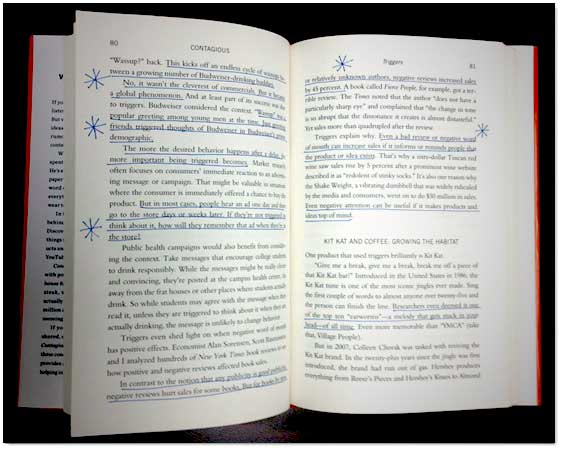
When I recently purchased the book “Contagious: Why Things Catch On” (by Jonah Berger), I didn’t know what to expect. I saw positive reviews and a friend of mine insisted that I’d like it, but I just wasn’t sure.
Fast forward a day or two and the book was done. You could say I swallowed the book whole. And if underlines and asterisks are any measure, I learned a lot reading it.

Image: my (marked up) copy of “Contagious,” by Jonah Berger.
I think “Contagious”
should be read by all marketers. Why? Because Berger helps us understand “why things catch on” and that helps to inform marketing content and marketing campaigns.
Berger’s Six Principles
“Contagious” provides six principles that serve as the foundation of why things catch on. They are:
- Social currency: We share things that make us look good.
- Triggers: Top of mind, tip of tongue.
- Emotion: When we care, we share.
- Public: Built to show, built to grow.
- Practical value: News you can use.
- Stories: Information travels under the guise of idle chatter.
I visit Starbucks a few times of week for an afternoon cup of coffee. When I looked it up on Yahoo! Finance, I wasn’t surprised to see that Starbucks has a market cap over $60B. I decided to back-track on the growth of Starbucks and see
how many of Berger’s principles apply.
Let’s have a look.
What Makes Starbucks “Contagious”
Social Currency
Let’s face it: the Starbucks cup (and logo) has social currency.
People like to be seen with it. When I walk past the 24 Hour Fitness near my office, a young man is walking on a treadmill with a Starbucks cup in the cup holder. When I visit the post office, a Starbucks cup rests on the counter. When I visit a different coffee shop, I’ll see a person holding a Starbucks cup, even though the establishment sells coffee! In short, people use real currency (when buying a cup of Starbucks) in order to attain social currency.
Triggers
I don’t drink coffee in the morning, but my “Starbucks trigger” is whenever I
get a little tired in the late afternoon. We have a Starbucks a block away from the office, so I’ll ask a colleague to walk with me to Starbucks. We’ll have a conversation on the way and I’ll return to the office with my cup. I’ve checked in with that employee and I’ve fulfilled my trigger.
Emotion
“We have always believed Starbucks can - and should - have a positive impact on the communities it serves. One person, one cup and one neighborhood at a time.”
That’s the main heading on a web page from Starbucks titled “Being a Responsible Company.” By thinking and acting as a socially responsible company, brands can build stronger emotional connections with their customers. I don’t know that this emotional connection applies so much to me, but it does apply to some of my friends and family members.
Public
Starbucks’
green mermaid is everywhere: it’s the quintessential “walking brand.” Where it goes, everyone knows. Because Starbucks’ products were consumed in public and because they could be taken “mobile,” the Starbucks brand quickly gained prominence (not to mention the fact that they had an aggressive rate of new store openings). This, combined with social proof created a virtuous cycle. The more public it became, the more non-customers were encouraged to become customers.
Practical Value
Remember, the Starbucks story is
more than just the coffee. For some, Starbucks was a convenient place to meet with a prospective client (after ordering cups for you and the prospective client, of course). For others, it was the one place you could get a free WiFi signal (before many other establishments hopped aboard the bandwagon). For yet others, it was the experience of hanging out and relaxing while hip music played on the speakers. In all cases, Starbucks grew its revenue (and brand) by providing practical value to go alongside its coffee.
Conclusion
“Contagious” is one of the best books I’ve read in 2013. In breaking down “why things catch on,” Berger provides useful lessons for organizations. Business leaders should read the book for insights on how their products and services could catch on, while marketing leaders should read the book to create more share-worthy content.
Related Presentation
We’ve assembled a related presentation on what makes Starbucks “Contagious” – feel free to view the slides below.
How the Starbucks Experience Became Contagious from DNN